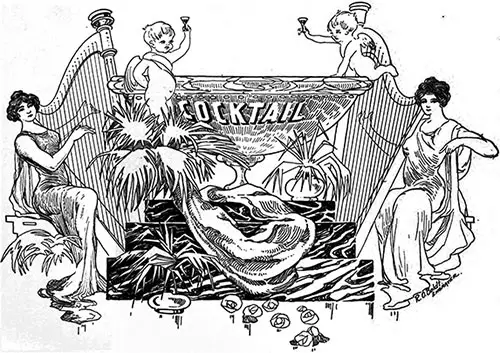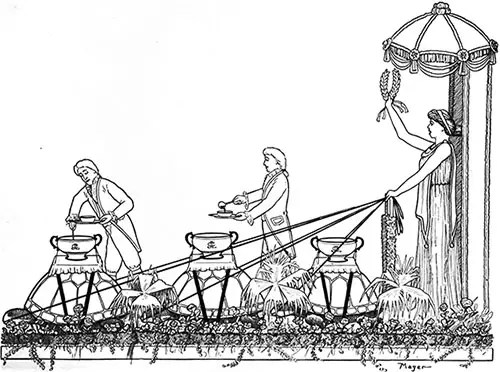Serving a Dinner for $2,500 per Plate in 1915
When Madame Jackson Crocker Gouraud asked through the New York American for original suggestions for serving a dinner for a special occasion, for which she offered $5,000, the American Gastronom submitted the following Menu, explanations, and designs, for serving the same:
Name—Le Grand Diner Au Naturel a l'Hors Concours—One hundred covers at twenty-five hundred $2,500 a plate, including food, wines, service, decorations, staging, musical entertainment, noted talent, necessary costumes, etc. Nothing shall be left undone for the absolute comfort of the guests.
Place—Glass pavilion especially constructed for the occasion, in Cannes, south of France. The interior decoration to resemble an Amazon Garden. The floor to be laid out as a natural green lawn. Blooming Century plants shall be a part of the floral groups in corners. The illumination shall be moderately bright, the shades to be tested first and compared with the green effect. Miniature fountains, ornamented with cupids, supply the wines.
The Table Plan—Two rows of round tables especially constructed, raised one foot from the floor, fifteen feet apart; between the two rows of tables a ten-foot wide moving platform to run between the rows of tables from one end of the room (the entrance) to the other end (the exit).
Four guests to be seated at each table so that everyone faces the moving platform. The large entrance to the dining room leads from the service-room, which is to be transformed into a stage. A rising curtain divides the dining-room from the stage service room.
All courses of the dinner- to appear as "tableaux vivants" or groups, which are placed stationary on the platform. An electric signal given by the hostess raises the curtain at the stage entrance, and then the live tableau appears and proceeds on the moving platform until it reaches the center.
The curtain drops as soon as the group enters the dining-room.
Every course shows the article of food, both in nature and cooked. Heavy liveried lackeys dressed in knickerbockers and white wigs are lined up on both sides of the tables to receive the groups from which everything is served to the guests. The wine butlers are dressed in monk's costumes.
A small electric keyboard is to be provided at the side of the hostess' seat, giving her the control of directing the proceedings of the dinner by simply pressing the button.
Before the dinner actually starts, the hostess presses the button, the curtain rises and a Steinway grand moves in noiselessly on the platform, with Paderewsy sitting at the keys, playing the overture. As soon as this is over, the piano with the great artist rolls out at the other side, through the exit.

Cocktail Tableau for the $2,500 per Plate Dinner
Tableau No. 1—The Cocktail.
The hostess again presses the button, the curtain rises and here comes the cocktail served in a large stone fountain beautifully mounted, such as are used for baptizing in the Catholic Church; two female harpists, dressed in light silk, sitting on each side of the large stone bowl, playing soft tunes of some celebrated selection. Floral decorations finish the group.

Tableau No. 2 — The Hors d’Oeuvre.
Crocodile eggs with caviar dressing, prepared by Escoffier, and served on the back of a crocodile on a dish especially constructed, as long as the crocodile; a couple of Hottentots stationed on each side playing their native instruments. You will notice, also, that the service is not only artistic but very practical to handle by the servants.

Turtle Soup Service for $2,500 per Plate Dinner
Tableau No. 3—The Soup: Turtle soup.
The curtain rises again, and there are six live giant turtles rolling in, in pairs, bearing on their backs the large soup tureens, confining the turtle soup. In the rear of the turtles, Mary Garden sings the "Meditation of Thais." Large silk ribbons are strung from the turtles to the great actress, this giving the appearance of six in hand, but turtles instead of horses. The soup to be made from my recipes from Barbados.
Tableau No. 4—The Fish.
A miniature aquarium with artistic bridges laid across, and live trout, swimming in the water. The bridges are to be removed and thereon the
trout are served in jelly. A group of Tyrolean singers in native costume sit around the aquarium and sing Tyrolean airs.
Tableau No. 5—The Choice Entrees.
One is monkey stew, the other bear steaks, served as follows: Four live bears, with chains fastened in their noses, wheel in an artistically
decorated wagon, bearing the platters, on which the stew and steaks are served; at each side stationed Italian hand-organ players, who are noted singers, with live monkeys on their shoulders.
Tableau No. 6—Tiger Roast.
A fine specimen of a Bengal tiger in a beautiful gold cage, beautifully ornamented, moves in on the platform. On the iron bars are fastened
the gold platters, from which the delicious white tiger roast is served. In the rear of the cage, Sousa's band plays the Marseillaise, in order to make the beast wild, and lend excitement to the audience.
Tableau No. 7 - The Dessert.
Peach Melba, Madame Melba appears on a gorgeous decorated chariot, live white pigeons fastened to the ancient vehicle, and men in ancient Roman costume, carry the golden trays with the peaches a la Melba, while Mme Melba renders a marvelous song.
Tableau No. 8—The Demi-Tasse.
A group of Arabs in their native costumes roll in on the slow-moving platform, and the guests can watch the Arabs making Turkish coffee
and then serving it.
Then come the Field Minstrels, playing the latest Tango hits—where everybody joins in the dance.
During short intervals, men like Harry Lauder, Little Titch, Joe Welch or the “dumme August" of the London Hippodrome take care of the entertaining, while a dozen Geisha maids act as natural fans when the atmosphere gets too hot.
The menu cards shall consist of original hand paintings.
"Serving a Dinner for $2,500 a Plate," in World's Fair Menu and Recipe Book: A Collection of the Most Famous Menus Exhibited at the Panama-Pacific International Exposition, San Francisco: The Lehner and Sefert Publishing Company, 1915, p. 137 - 140.
